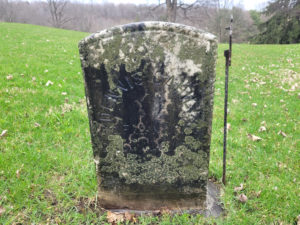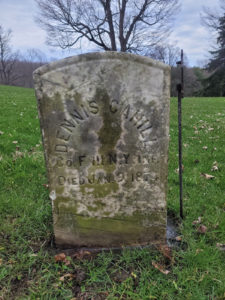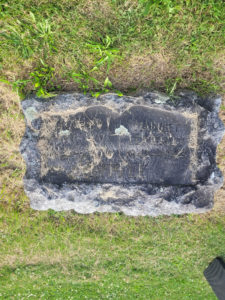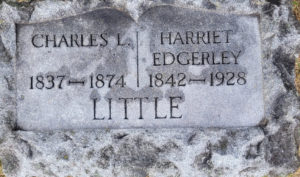

Headstone Cleaning
Suggested Cleaning Kit-
5 gallon bucket (to carry everything and sit on) $0 to $5
Clean water if the cemetery doesn’t have water available
Scrub brushes (large, medium and small) $10-$15 at the hardware store
Pump type garden sprayer $15-$20 (get from hardware store or online. The larger Harbor Freight model’s are junk, however, the HF half-gallon sprayer is quite nice!)
Plastic scrapers of various sizes $5 at hardware store
Old tooth brushes (or buy a package of 10 online)
Trigger type spray bottles , 2 minimum (save from house hold cleaning)
D-2 Treatment $30-$50 (see below)
Clipboard, pencil for notes
Rubber Gloves if you want
Kneeing pad $5 at Harbor Freight
Bamboo skewers (raid the BBQ supplies for a few)
Orvus WP soap $30 at TSC (will last a long time)
The instructions and recommendations below have been researched and tried by the Lock 52 Historical Society over the 2022 season. (A video of a simple cleaning can be seen on YouTube and a pdf of these instructions can be downloaded here.) The instructions are all based around the prime directive to DO NO HARM. All grave stones and monuments are not the same. Stones can be field stone, sand stone, lime stone, marble, or granite, and the quality varies depending on what quarry they were taken from, and the chemical properties of the stone. Even things like age, placement in the cemetery, the construction, environment, can all have an effect on the stone.
A 1 or 2 gallon pump type sprayer filled with clean water will aid in the cleaning process. Never use a pressure washer! (Battery powered garden sprayers can reduce the amount of work to pump and maintain pressure.) The smaller half-gallon pump sprayers can be very handy for quick applications of soap or water. They don’t deliver enough pressure to wash soap and dirt clean, but they are nice for the tool kit.
All brushes should have soft nylon or natural fibers. Never use a metal brush or a 3M type scouring pad! A variety of sized brushes will make things easier. A large scrubbing brush to start and working down to a toothbrush size for the inscriptions. Brushes with handles can be easier to hold onto. Experiment with them.
Have at least 2 trigger type spray bottles, one with soap and and other with water. These will be used to keep the stone wet and soapy.
Orvus WP soap is non-ionic and neutral pH. It is used as a livestock shampoo and by quilters for safe cleaning. Ionic soaps (most of them) will clean but the residue left behind will attract dirt and pollution and those with a high or low pH can damage the stone.
A note here about D-2. This product is the only treatment approved by the National Park Service on historic buildings and monuments. D-2 can be sprayed on and left to work on its own or as part of the cleaning process. At $50 a gallon it can be pricey to use however the results are remarkable. The instructions below use the D-2 at the very end of the process to minimize the cost, however, D-2 can be used throughout if you wish. Or if you are on a budget, you can skip altogether. Other treatments such as Scrubbing Bubbles, Wet and Forget, bleach; should be avoided. There is some study with Wet and Forget on granite stones, but as the main rule is to do no harm, these recommendations only use D-2.
D-2 can be found online at Atlas Preservation or at local monument companies.
Before You Start
To begin, think about when do we hand clean and when don’t we? The prime directive is to DO NO HARM. We clean because the stone is dirty or covered in growth. We clean because it makes it readable and suitable for photos. We clean out of respect. We don’t hand clean when the stone shows weakness or damage, or when the possibility of harm to you or the stone. Weak, fragile, or dangerous stones can be treated with D-2 and left.
Instructions
- Be sure that you have permission. If you are cleaning your family stones, then go ahead and have fun. If you are wanting to clean miscellaneous stones at the local cemetery, be sure that you ask permission.
- Evaluate the stone. Are there any splits or cracks? Is it granite, marble, sandstone, slate? Is the stable enough to press against as you scrub it? Does it rock due to a poor foundation or have loose pieces? Does it show prior repairs?
- Take photos of front and back of stone prior to any work. If you willing to use the Find-A-Grave or Billion Graves app, use them to document and record the location of the stone. (You will need to have a free account to use these and be sure to have your phone’s GPS function turned on so that the app will record the location.) Photos can be helpful if you are ever accused of causing damage by way of your good deeds!
- Get started! Wet the stone down thoroughly. Then spray with soap.
- Work from top to bottom in small areas. Work progressively. First, use the plastic scraper to remove moss, lichen, larger growths, etc. Then gently scrub with a large brush using a circular motion. Remember to wet, scrub, wet to rinse away dirt, scrub and continue working. As you work, use the smaller brushes to clean inscriptions, details, etc. Each layer of grime that is removed will reveal more grime, moss, mold, etc.
- Although the back of the stone is not as sexy as the front, a quick cleaning will make it look better and help slow the deterioration from dirt and pollution.
- Once you are done, rinse well with water. Then apply the D-2 and do not rinse. The D-2 will continue to work for a long time after the cleaning. The D-2 will turn the stone a burnt-orange color. This is normal and means the the treatment is working. It will disappear after a couple days.
- Take another photo for a before and after.
Note! Remember that less is more. You may not be able to get the stone perfectly clean. Clean what you can and let the D-2 do its work.


If you find that the stone is already on the Find-A-Grave app, check to see if the location has been added. Some of the older photos did not have the location features added. Plus, think about adding a photo that shows a wider perspective so you can see some of the neighboring stones, monuments, roads, etc. This way someone can use the visual clues to help find the stone.
If you want to watch some videos, here are some suggested links.
Version 10.16.2022